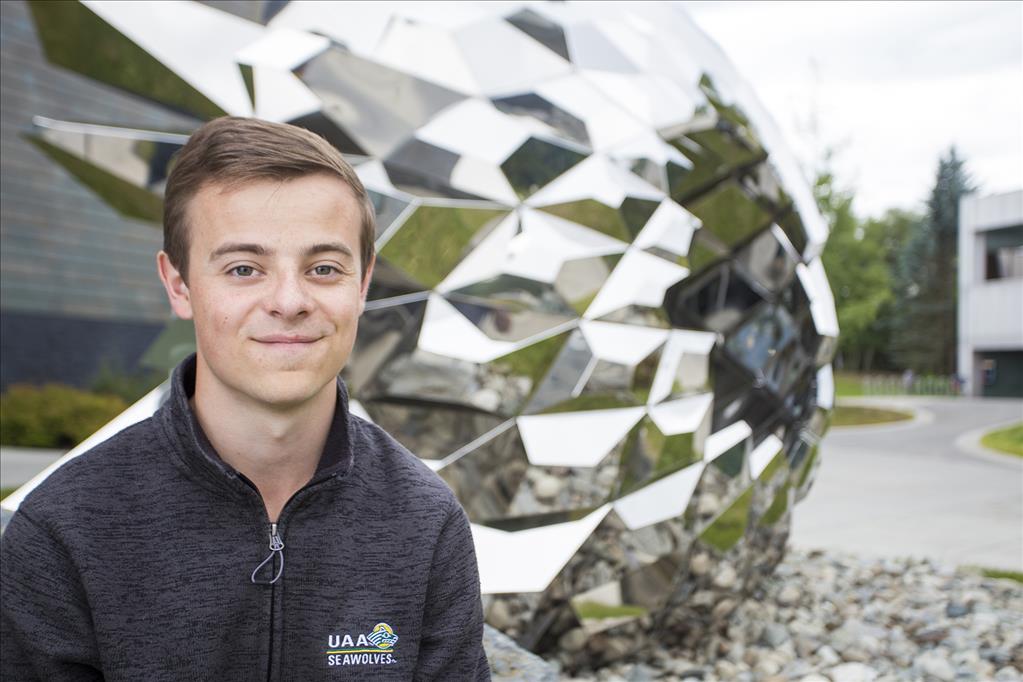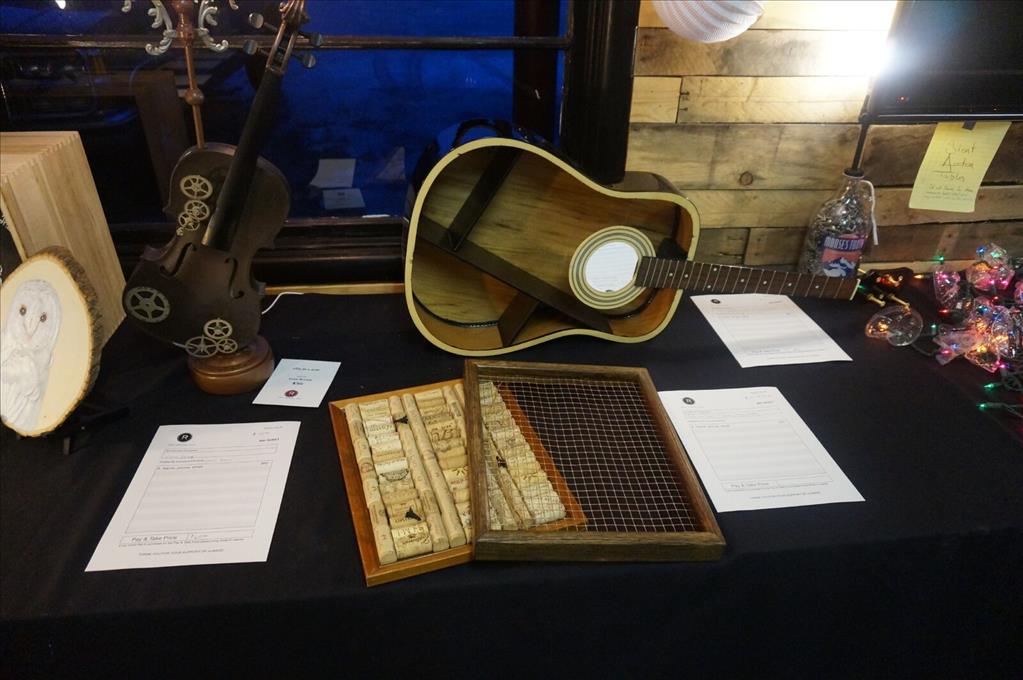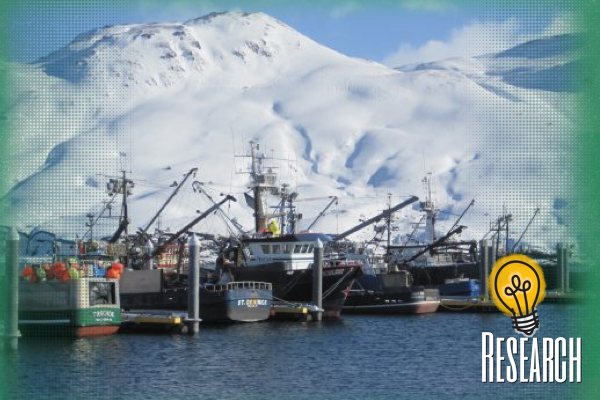Geological Society of America names UAA professor as a fellow
by Tracy Kalytiak |
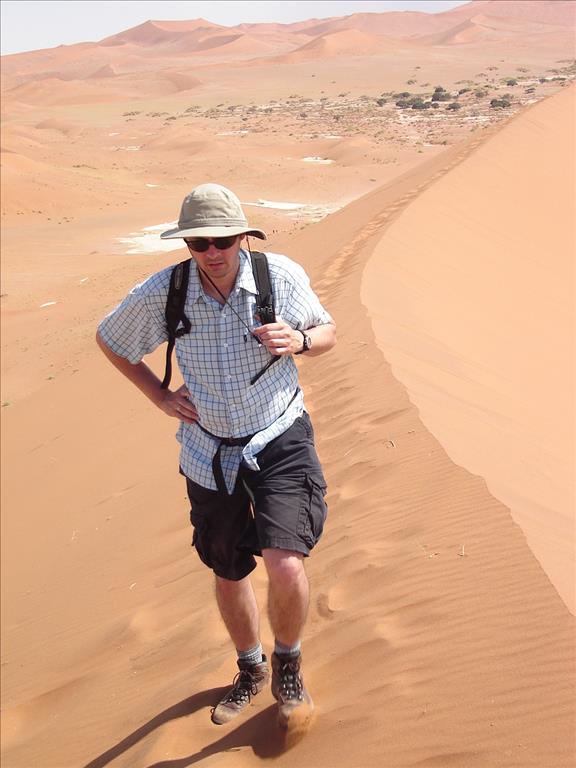
UAA's Dr. Simon Kattenhorn hikes along a sand dune in the Namib Desert at Sossusvlei, Namibia. The Geological Society of America recently honored Kattenhorn by naming him as a GSA fellow. (Photo courtesy of Simon Kattenhorn)
Many geologists would say rocks and minerals enticed them into their line of work.
Not Simon Kattenhorn.
As a child, the phenomena of volcanoes, earthquakes, plate tectonics and planets seized and then held his attention as he moved toward deciding on a career.
"I wanted something that could combine all those things," said UAA's director of the Department of Geological Sciences, professor of structural geology and, now, a newly minted Geological Society of America fellow. "I was very interested in physical processes."
Investigating plates, faults and rifts
Kattenhorn's father was a machinist; his mother worked in the hotel industry. They loved to travel, moving their four children from England to Australia and on to South Africa, where Kattenhorn became the first person in his family to go to college - earning geology and physics baccalaureate degrees at South Africa's University of KwaZulu-Natal; a master's degree in geology at the University of Akron in Ohio and a doctorate in geological and environmental sciences at Stanford University.
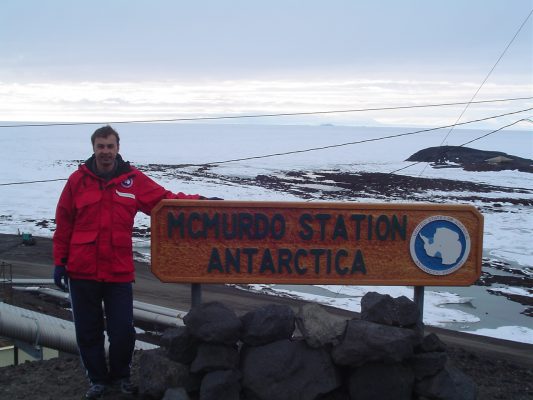
UAA's Simon Kattenhorn works on research at McMurdo Base, Antarctica. (Photo courtesy of Simon Kattenhorn)
His passion for learning and teaching geology brought Kattenhorn to a little-known fault in California, the magnificent ruddy canyons of southern Utah, East Africa's Great Rift Valley, polygonal faults in the chalk of Egypt's Khoman Formation. He's also worked in Ecuador, Iceland, Europe, and the empty expanses of Antarctica to tease out answers to intricate riddles posed by Earth's tectonic plates, earthquake faults, and rift valleys.
One puzzle involves continents, thick slabs of ancient "lithosphere" - the solid outer part of the planet - that are also buoyant, sitting higher than ocean basins that, because they are low, fill with water.
"Continental lithosphere is really thick, so it's hard to understand that if there were some forces that were able to pull on it in an attempt to break it apart, why doesn't it just break around the edges?" Kattenhorn asked. "Why does it break right in the middle?"
The scientist said that puzzle about plate tectonics is a longstanding question in geoscience. "The work we've been doing in East Africa," he said, "is looking at some of the youngest portions of the Rift that have only been developing for a few million years, to try and understand the processes at work and see if that gives us insights into how we can rift through very thick lithosphere."
Solving mysteries, opening understanding
While he hasn't physically visited Europa, a moon of Jupiter, or Phobos, a Martian moon, Kattenhorn's research calculations and collaborations have opened valuable insights into both.
Three years ago, Kattenhorn and a collaborating scientist from the Lunar Planetary Institute in Houston published a paper about Europa: "We actually made a case that we feel we've discovered plate tectonics on Europa," he said, "so it would be in ice, and it would be the only other solar system body that has a system of plate tectonics other than Earth. It's a mystery."
Kattenhorn is part of a collaborative team with members from a range of disciplines, including a geodynamicist who studies convection within the ice to see what could possibly drive a plate tectonic system.
"But it's not icy plates moving over water, which is what everyone assumes," Kattenhorn said. "It's actually really cold, very brittle ice moving on top of - and I know this sounds weird to say - warm ice. So warm ice is still below freezing 'cause it's ice, but it's ice that is actually able to convect. Just heat trying to get out of the moon from the ocean below out to the vacuum of space; the extreme cold of space creates a gradient in heat."
He compared the action to the boiling of water: "Of course that's a liquid," Kattenhorn said. "We know that's also how heat moves around in earth's mantle and earth's mantle is not a liquid; it's a solid."
On Europa, the moving ice carries heat with it and brings it up to shallower depths where it can conduct through the uppermost part of the ice.
"We know Earth's tectonic plates are partially driven by the convection of the mantle. The convection within the ice on Europa may be helping to drive that plate tectonic system."
Kattenhorn says the ideas are merely a hypothesis right now yet sparked interest in the planetary science community. The team's paper was published in Nature Geoscience.
A tiny (10 by 14 by 11 miles in diameter) dark, dusty, potato-in-orbit is another focus of Kattenhorn's research.
Phobos is not actually a potato - though it strongly resembles one. It's a moon that is closer to its planet - Mars - than any other moon in the solar system, orbiting 3,700 miles above the Martian surface and completing an orbit once every 7.65 hours.
Phobos is doomed, however, because tides that the irregularly shaped satellite raises on Mars lag behind its orbital position.
This lag inflicts stress, which distorts Phobos' orbit at a rate of seven-tenths of an inch per year. Its orbits will continue to decay, for tens of millions of years, until Phobos either collides with Mars or is ripped to bits and scattered as a ring around the red planet.
Kattenhorn took part in research - published in the Journal of Geophysical Research - revealing the first signs of trouble are already visible on Phobos' surface.
"Most of Phobos' prominent grooves have an excellent correlation with computed stress orientations," the article's abstract states.
Motivating students to succeed
Kattenhorn worked as a teaching assistant back when he was earning his master's degree. That passion for teaching remains strong.
"I got to see how you could make a tremendous impact on somebody just by fostering their developing interest in the field of earth science," he said, "and providing encouragement to folks who - with just a little bit of encouragement - can turn their life around and realize they can achieve success in pursuit of a baccalaureate degree, for example."
He often worked with nontraditional students.
"It's very challenging to go back and try to obtain a degree," he said, "and I really enjoyed being able to work with students, particularly students who may have needed just a little bit more personal attention than they'd typically get in a large-format class. I loved that aspect of teaching."
Kattenhorn accepted a tenure-track position at the University of Idaho immediately after earning his doctorate at Stanford University.
"That gave me the opportunity to develop my own independent research program coming back to those aspects that really interested me, including earthquake studies and planetary science," he said.
After 16 years at the University of Idaho, Kattenhorn left academia for a couple of years to work with ConocoPhillips - and now conveys his industry-relevant insights through field projects UAA students participate in.
Utah is one place he has taken his students for field work.
"I just took 15 students from UAA down to Utah in the middle of April because there are so many features there that are pertinent to structural geology for oil and gas," he said. "There are really amazing teaching laboratories to be had, where you can go out of the way. You don't have to fight for access to viewing areas because you have to hike 15 miles to go see what you want to see." He laughed: "Geology students are all for that, and that's what we did."
The area is not a producing oil and gas area - the Colorado Plateau is actually an ancient oil and gas reservoir that was naturally lost.
"So the seal was broken and the hydrocarbons all escaped millions of years ago," Kattenhorn said. "But you see the evidence of this. All the pieces of the puzzle are still in place that help students understand what an oil reservoir is, and what conditions you need to keep oil under the ground."
Kattenhorn explained that tens of millions of years ago, something happened at the plate tectonic scale to cause the elevation of the entire Plateau area to increase.
"And that's why it forms the canyonlands," he said. "The Colorado River and all its tributaries started eroding down into the land as it rose up around it - the river still has to just go down to sea level - so that's why we have all the canyons, including Grand Canyon. This was just the rivers eroding down into the landscape."
Receiving accolades
Judith Parrish, a GSA fellow and longtime member from the University of Idaho, nominated Kattenhorn for the GSA fellowship honor, which recognizes distinction in the publication of geologic research, training of geologists and administration of geological programs.
"Dr. Simon A. Kattenhorn demonstrates excellence in research in structural geology and planetary geology, and is a gifted teacher and valued colleague," she wrote.
The nomination was supported by two letters: one from David Pollard at Stanford University and another from Louise Prockter of the Lunar and Planetary Institute.
Kattenhorn's name will be published in the July issue of GSA Today and the GSA will honor him Oct. 22 at the Presidential Address and Awards Ceremony in Seattle.
Kattenhorn hopes geology will infuse, inform and energize the lives of his students in the same way it energized his.
"I went straight into the geology major and there was no looking back," Kattenhorn said of his academic entry into geological science. "I loved it from day one; I love it to this day; I never grow tired of it."
Written by Tracy Kalytiak, University of Alaska Anchorage
 "Geological Society of America names UAA professor as a fellow" is licensed under a Creative Commons Attribution-NonCommercial 4.0 International License.
"Geological Society of America names UAA professor as a fellow" is licensed under a Creative Commons Attribution-NonCommercial 4.0 International License.










